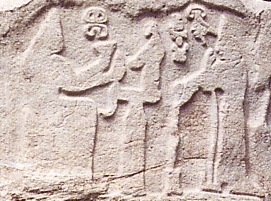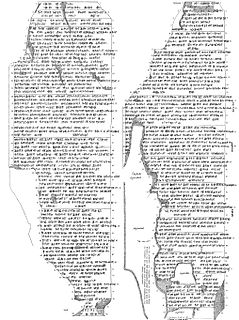Hantili II | |
|---|---|
| Predecessor | Alluwamna |
| Successor | Zidanta II |
| Parent(s) | Alluwamna Harapšeki |
| Relatives | Zidanta II (possibly nephew) |
Hantili II was a king of the Hittites (Middle Kingdom) in the 15th century BC.
Hantili II | |
|---|---|
| Predecessor | Alluwamna |
| Successor | Zidanta II |
| Parent(s) | Alluwamna Harapšeki |
| Relatives | Zidanta II (possibly nephew) |
Hantili II was a king of the Hittites (Middle Kingdom) in the 15th century BC.
Hantili was a son of King Alluwamna, as attested in a land grant document from Alluwamna to his son, Hantili. [1] His mother was likely Queen Harapšeki, the daughter of the King Telipinu. Hantili is mentioned on the offering lists right after Alluwamna. The later king Zidanta II was possibly Hantili's nephew. [2]
Hantili was the first great king in several generations to receive the royal blood from his father. [3]
There is an alliance treaty with the king Paddatishu of Kizzuwatna with an unnamed Hittite king, who could be either Hantili II or his father Alluwamna. [1] It is unclear, though, whether Hantili reigned right after Alluwamna, or if an interloper Tahurwaili reigned in between. It is also possible that Tahurwaili reigned after Hantili II. Most likely, though, that Tahurwaili reigned before Aluwamna, and Hantili was succeeded by Zidanta II [4]

Full text of Endowment Inscription of Hantili II from the Middle Hittite Age found in Boğazköy: [5]
"The seal (sealed endowment document) of the Great King Tabana ("The Ruler"): The Great King received from the uriyannis on the right (sitting to the right of the king at the meeting or on the right wing in the battle formation) and from, the head of the guard detachment ("harpooner's head"), Haššuili. And gave it to Haššuili, the head of the guard detachment ("harpooner's head"), as a gift. In the future, no one will be able to claim (for this endowment) from Haššuili and his grandchildren! The word of the Great King Tabarna is of steel. It cannot be thrown aside and broken! Whoever changes it, they will be beheaded. This tablet was written in Hatti land by the clerk Hannikuili in front of Iškunaššu, the head of the palace boys, Šarpa and the commander of the army inspectors."
The inscriptions around the eight-leaf rosette in the middle on the king's seal in front of the tablet in English:
On the outer ring: "The seal of the Great King Tabarna Hantili."
In the inner ring: "Whoever changes his word (tablet) will die!"
The Great King Tabarna referred in this inscription is Labarna II (Hattusili I) and the word of the Great King Tabarna is Testament of Hattusili I.

The Battle of Kadesh or Battle of Qadesh took place between the forces of the New Kingdom of Egypt under Ramesses II and the Hittite Empire under Muwatalli II at the city of Kadesh on the Orontes River, just upstream of Lake Homs near the modern Lebanon–Syria border.
Mursili I was a king of the Hittites c. 1620-1590 BC, as per the middle chronology, the most accepted chronology in our times,, and was likely a grandson of his predecessor, Hattusili I. His sister was Ḫarapšili and his wife was queen Kali.

Muwatalli II was a king of the New Kingdom of the Hittite empire c. 1295–1282 and 1295–1272 BC in the short chronology.
Mursili III, also known as Urhi-Teshub, was a king of the Hittites who assumed the throne of the Hittite empire at Tarhuntassa upon his father's death. He was a cousin of Tudhaliya IV and Queen Maathorneferure. He ruled ca. 1282–1275 BC or 1272–1265 BC.

Tudhaliya IV was a king of the Hittite Empire, and the younger son of Hattusili III. He reigned c. 1245–1215 BC or c. 1237–1209 BC. His mother was the great queen, Puduhepa.
Hattusili I was a king of the Hittite Old Kingdom. He reigned ca. 1650–1620 BCE, or 1586–1556 BCE. Excavations in Zincirli Höyük, Southern Turkey, suggest that Hattusili I destroyed a complex at that site in the mid to late 17th century BCE, which can confirm the middle chronology dating for his reign. This event could have been part of his campaign against Zalpa in order to disrupt an exchange network connected to Aleppo that previously linked the Euphrates, North Syria, and Central Anatolia.
Adad-nārārī I, rendered in all but two inscriptions ideographically as mdadad-ZAB+DAḪ, meaning “Adad (is) my helper,” was a king of Assyria during the Middle Assyrian Empire. He is the earliest Assyrian king whose annals survive in any detail. Adad-nārārī I achieved major military victories that further strengthened Assyria. In his inscriptions from Assur he calls himself son of Arik-den-ili, the same filiations being recorded in the Nassouhi kinglist. He is recorded as a son of Enlil-nirari in the Khorsabad kinglist and the SDAS kinglist, probably in error.
Kizzuwatna, is the name of an ancient Anatolian kingdom in the 2nd millennium BC. It was situated in the highlands of southeastern Anatolia, near the Gulf of İskenderun, in modern-day Turkey. It encircled the Taurus Mountains and the Ceyhan River. The centre of the kingdom was the city of Kummanni, in the highlands. In a later era, the same region was known as Cilicia.

Kussara (Kuššar) was a Middle Bronze Age kingdom in Anatolia. The kingdom, though apparently important at one time, is mostly remembered today as the origin of the dynasty that would form the Old Hittite Kingdom.
Zidanta I was a king of the Hittites, ruling for 10 years, ca. 1560–1550 BC or 1496–1486 BC. According to the Telepinu Proclamation, this king became a ruler by murder.
Kurunta was younger son of the early 13th century BC Hittite king Muwatalli II and cousin of Tudhaliya IV. Kurunta was thereby a Hittite prince and king of Tarhuntassa country. It has been suggested that he may have captured the Hittite capital for a very short time during the reign of the Hittite king Tuthaliya IV and declared himself a great king.

Nerik was a Bronze Age settlement to the north of the Hittite capitals Hattusa and Sapinuwa, probably in the Pontic region. Since 2005–2009, the site of Nerik has been identified as Oymaağaç Höyük, on the eastern side of the Kızılırmak River, 7 km (4.3 mi) northwest of Vezirköprü.

Puduḫepa or Pudu-Kheba was a Hittite queen, her companion being the King Hattusili III. She has been referred to as "one of the most influential women known from the Ancient Near East."
Alluwamna was a king of the Hittites in the 15th century BC. He might be a successor of Telipinu as his son-in-law, after the reign of Tahurwaili.
Tahurwaili was a king of the Hittites, c. early 15th century BC or mid 15th century BC. He was a cousin of the King Telipinu.

The Egyptian–Hittite peace treaty, also known as the Eternal Treaty or the Silver Treaty, is the only Ancient Near Eastern treaty for which the versions of both sides have survived. It is also the earliest known surviving peace treaty. It is sometimes called the Treaty of Kadesh, after the well-documented Battle of Kadesh that had been fought some 16 years earlier, although Kadesh is not mentioned in the text. Both sides of the treaty have been the subject of intensive scholarly study. The treaty itself did not bring about a peace; in fact, "an atmosphere of enmity between Hatti and Egypt lasted many years" until the eventual treaty of alliance was signed.

Kadašman-Turgu, inscribed Ka-da-aš-ma-an Túr-gu and meaning he believes in Turgu, a Kassite deity, was the 24th king of the Kassite or 3rd dynasty of Babylon. He succeeded his father, Nazi-Maruttaš, continuing the tradition of proclaiming himself “king of the world” and went on to reign for eighteen years. He was a contemporary of the Hittite king Ḫattušili III, with whom he concluded a formal treaty of friendship and mutual assistance, and also Ramesses II with whom he consequently severed diplomatic relations.

Kadašman-Enlil II, typically rendered dka-dáš-man-dEN.LÍL in contemporary inscriptions, meaning “he believes in Enlil” was the 25th king of the Kassite or 3rd dynasty of Babylon.
Kudur-Enlil, rendered in cuneiform as Ku-durdEN.LÍL, “son of Enlil,” was the 26th king of the 3rd or Kassite dynasty of Babylon. He reigned into his ninth year, as attested in contemporary economic tablets. His relationship with his predecessor and successor is uncertain and does not appear in contemporary inscriptions. The personal name “Marduk is king of the gods” first appears during his reign marking the deity’s ascendancy to the head of the pantheon.

The Kingdom of Mira was one of the semi-autonomous vassal state kingdoms that emerged in western Anatolia after the destruction of the Arzava Kingdom by the Hittite Empire.